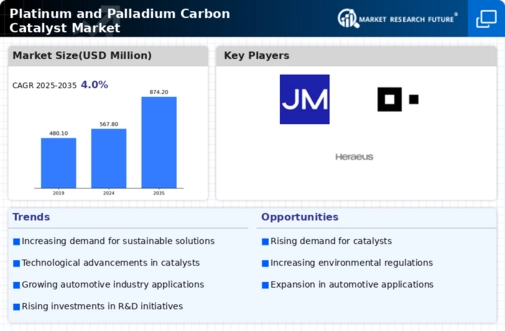Market Growth Projections
The Global Platinum and Palladium Carbon Catalyst Market Industry is projected to experience substantial growth over the next decade. In 2024, the market is valued at 567.8 USD Million, with expectations to reach 874.2 USD Million by 2035. This growth trajectory indicates a compound annual growth rate of 4.0% from 2025 to 2035. The increasing demand for catalytic solutions across various sectors, coupled with technological advancements and regulatory pressures, is likely to drive this expansion. As industries continue to prioritize sustainability and efficiency, the market for platinum and palladium catalysts is poised for a promising future, reflecting the evolving landscape of catalysis.
Growing Demand in Automotive Sector
The Global Platinum and Palladium Carbon Catalyst Market Industry experiences a notable surge in demand driven by the automotive sector's increasing focus on emissions reduction. As governments worldwide enforce stricter emission regulations, automotive manufacturers are compelled to adopt advanced catalytic technologies. Platinum and palladium catalysts play a crucial role in converting harmful exhaust gases into less harmful emissions. In 2024, the market is projected to reach 567.8 USD Million, reflecting the automotive industry's shift towards cleaner technologies. This trend is expected to continue, with the market anticipated to grow significantly as electric vehicle adoption rises, further enhancing the demand for efficient catalytic solutions.
Increasing Environmental Regulations
The Global Platinum and Palladium Carbon Catalyst Market Industry is significantly influenced by the rise of environmental regulations aimed at reducing pollution. Governments globally are implementing stringent policies to curb emissions from industrial processes and vehicles. This regulatory landscape compels industries to adopt platinum and palladium catalysts, which are effective in minimizing harmful emissions. The growing awareness of environmental sustainability further drives this trend, as companies seek to comply with regulations while enhancing their corporate responsibility. As a result, the market is expected to witness a compound annual growth rate of 4.0% from 2025 to 2035, reflecting the increasing reliance on catalytic technologies to meet regulatory standards.
Rising Investment in Renewable Energy
The Global Platinum and Palladium Carbon Catalyst Market Industry is also influenced by the rising investment in renewable energy technologies. As the world shifts towards sustainable energy sources, the demand for efficient catalytic solutions in hydrogen production and fuel cells is increasing. Platinum and palladium catalysts are essential in these applications, facilitating critical reactions that enable the conversion of renewable energy into usable forms. The growing emphasis on green technologies and the transition to a low-carbon economy further enhance the market's potential. This investment trend is likely to bolster the market's growth, aligning with the broader global movement towards sustainability and energy efficiency.
Technological Advancements in Catalysis
Technological innovations in catalytic processes are propelling the Global Platinum and Palladium Carbon Catalyst Market Industry forward. Continuous research and development efforts have led to the creation of more efficient catalysts that enhance reaction rates and reduce precious metal usage. For instance, advancements in nanotechnology have enabled the development of catalysts with improved surface area and activity. These innovations not only optimize performance but also contribute to cost-effectiveness in industrial applications. As the industry embraces these cutting-edge technologies, the market is poised for growth, with projections indicating a market value of 874.2 USD Million by 2035, showcasing the potential of innovative catalytic solutions.
Expansion of Chemical Processing Industries
The Global Platinum and Palladium Carbon Catalyst Market Industry benefits from the expansion of chemical processing industries, which utilize these catalysts in various applications. Industries such as petrochemicals, pharmaceuticals, and fine chemicals rely on platinum and palladium catalysts for their efficiency in facilitating chemical reactions. As these sectors grow, driven by rising global demand for chemical products, the need for effective catalytic solutions becomes paramount. The market's growth trajectory is supported by the increasing complexity of chemical processes, necessitating advanced catalysts to ensure optimal performance. This trend is expected to contribute to the overall market growth, aligning with the projected increase in market value over the coming years.







Leave a Comment